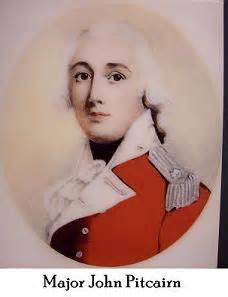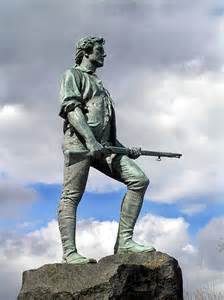Lexington Part II – “Our troops advanced towards them, without any intention of injuring them.” Who Fired First at Lexington?

The above words were written by Lt. Col. Francis Smith in his official report to General Thomas Gage. Smith, in command of the British expedition to Concord recently returned from what would be the opening salvo of rebellion. Smith wanted to be clear that he never intended to start bloodshed. In the days afterwards, the Massachusetts militia made it clear that they intended to lay the blame at the “regulars.” As soon as the British returned to Boston, the war of words began on who fired the first shot to begin a worldwide war. The British column that was led by Smith was sent from Boston to capture supplies reportedly stored at nearby Concord. To get to Concord, the British would have to march through Lexington. Due to a complex warning system, the local militia in Lexington were mustered and called to arms. Captain John Parker and his minutemen were lined up on the Lexington green in two rows, facing the road to Cambridge and the Lexington meetinghouse. The road south of the green headed to Concord, and Parker had his mean assembled on the northern portion of the green, away from the Concord road.
As the advanced party of the British column approached Lexington, the “regulars” passed around to the north of the meetinghouse on the Lexington green. Just behind them, Maj. Pitcairn went around to the south of the meetinghouse and thus lost control of the of his vanguard. As Pitcairn called for Parker’s men to lay down their guns, some began to disperse. This was not enough for Pitcairn and he continued to call for them to lay down their weapons. At this point, someone from somewhere fired a gun – and that began a small, but bloody affair that would alter the course of history.
Although confusing, the events of the morning of April 19, 1775 are well documented. Dozens of eye witness accounts, reports and testimonies survive today. A few days after the skirmish at Lexington, the Massachusetts Provincial Congress began interviewing witnesses and taking sworn testimonies on what happened. Though many of the details are muddled, when one reads the nearly 100 testimonies one thing is clear – the British were the aggressors and fired the first shot to which the Americans returned fire to defend themselves.
The aggressive nature of the British is recorded by John Robbins of the Lexington militia; “huzzaing and on a quick pace toward us, with three officers in their front on horseback, and on full gallop towards us; the foremost of which cried, ‘Throw down your arms, ye villains, ye rebels;’ upon which said Company dispersing, the foremost of the three officers ordered their men, saying ‘Fire, by God, fire.”
“huzzaing and on a quick pace toward us, with three officers in their front on horseback, and on full gallop towards us; the foremost of which cried, ‘Throw down your arms, ye villains, ye rebels;’ upon which said Company dispersing, the foremost of the three officers ordered their men, saying ‘Fire, by God, fire.”
Sylvanus Wood a few years later stated “The officer then swung his sword, and said, ‘Lay down your arms, you damned rebels, or you are all dead men. Fire!’ Some guns were fired by the British at us from the first platoon, but no person was killed or hurt, being probably charged only with powder.” This would imply that the first volley by the British may have been blanks, but obviously they continued to fire with loaded rounds.
Captain John Parker issued a short statement on the skirmish at Lexington. It is telling as it is brief. In his statement he concluded “I immediately ordered our Militia to disperse and not to fire. Immediately Said Troops made their appearance and rushed furiously, fired upon and killed eight of our party without receiving any provocation therefore from us.” A veteran of the French and Indian War, Parker would not have put his men in undue danger and knew his men were no match for the British regulars. It is believable that he never intended his men to fire on the British (as was the case in several other previous encounters with the British and the local militia).

Among all the depositions, the most telling is the joint statement signed by nearly three dozen men who were on the Lexington green that morning. “Not a gun was fired by any person on the regulars, to our knowledge, before they fired on us.” Not one statement by the Americans that day claims to have fired at the British first.
The British accounts are less in number but do provide an alternate point of view. As Lt. Col. Smith said above, the British did not accept culpability for the beginning of blood shed. Major Pitcairn, who rode forward to take command of the British Light Companies that were entering Lexington wrote:
“When I came within about one hundred yards of them, they began to file off towards some stone walls on our right flank – – The Light Infantry observing this, ran after them – – I instantly called to the soldiers not to fire, but surround and disarm them and after several repetitions of these positive orders to the men, not to fire, etc. – – some of the rebels who had jumped over the wall, fired four or five shots at the soldiers.”
Pitcairn puts the blame on some militiamen who ran off the green to the protection of nearby stone walls. We do know that some of Parker’s men were dispersing as the British entered the green. But he claims his men only fired in response to being fired upon.
Another British account claims that they only fired in self-defense. Lt. John Barker wrote that he “saw a number of People, I believe 2 and 300, formed on a common in the middle of the Town; we still continued advancing, keeping prepared against an attack tho’ without intending to attack them, but on our coming near them they fired one or two shots, upon which our Men without any orders rushed in upon them, fired and put ‘em to flight; several of them were killed…”
What Barker’s comments do prove is that even eye witnesses get facts wrong. There were not 200-300 men formed on the Lexington green that morning, at most would be around 75. But that should not discount Barker’s other comments as they fall in line with other British sources. Some of which were private communications never meant to be used as part of the public debate.
The British saw this as open defiance to authority and the legal system which they believed they were all a part of and vowed to uphold. Armed insurrection was not the answer to a political debate. Also, the expedition to Lexington and Concord was not the first time the British had marched out of Boston to be confronted by armed militiamen. One can only assume many of the British were tired of dealing with what they saw as illegal rebels.
There is also a third option – which both sides are telling the truth and neither Parker’s

men nor Smith’s fired the first shot. There were dozens of people along the Lexington green watching the stand off. The town was alerted earlier in the evening and everyone was on edge. It is quite possible that someone from outside of the two companies on the green fired a shot.
Some of the American statements of the British rushing at them can be explained by a standard military maneuver. As the British approached, the men probably did “rush forward” but this was a standard maneuver from moving from column to line formation. And the British officers saw the minutemen dispersing as a means of defiance and not obeying orders. Also, the events that morning were hectic and tense. Though the British and militia had confronted each other before without bloodshed, each time was tenser. The situation was like a dry keg of gun powder that only need a small spark to explode.
It is clear the vast majority of men on both sides that morning did not want to begin a war or begin killing one another. As British Lt. Edward Gould summed up the confusion that morning best by writing “which party fired first, I cannot exactly say.”
The British presumably were under tighter discipline. The deployment from column to line would look threatening to those watching, but is an understandable maneuver under the circumstances. The British troops probably would not have fired until the redeployment was complete. They would have fired only when ordered to do so, and then they would have done it in volley, not a single shot. It is reasonable to suppose that the officer would not have ordered his men to fire without provocation. It also is difficult to believe that the officer in front would have achieved “full gallop” in that small area, or even that he would have charged unless he had ordered the whole formation to do so. Not that it really matters. That or something like it was bound to happen. It all happened so quickly that all memories would be confused and colored by what they wanted to believe, except perhaps the fellow that fired the shot and he wasn’t talking. Another possibility is an accidental discharge, which was a common enough occurrence with those weapons.
Dwight –
Thank you for your comments. I agree with you on the nature of the first shot…it was probably either an accident or someone NOT on the green. But with the situation as “charged” as that was…any sound of gun fire would have ignited general shooting. The British were very disciplined, though looking at what they had been through in the months leading up to this (constant harassment by Boston citizens, constant marching out to places around Boston to just be turned around when they met a militia force) and also what they had been through that morning – standing in knee high water in Cambridge waiting for the entire force to gather across the Charles River.